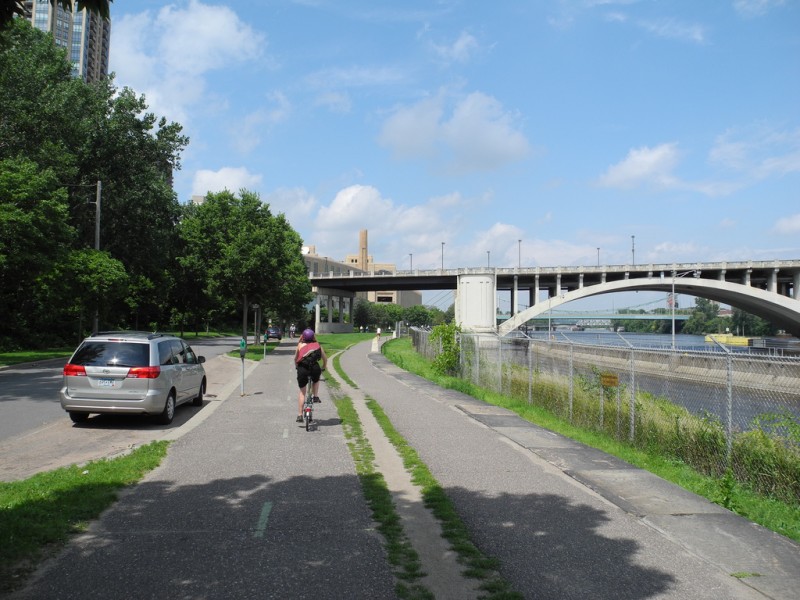Here’s a handy guide to different types of bikeways
_800_533_90.jpg)
Image by Joe Flood licensed under Creative Commons.
A version of this post was first published on August 17, 2011. It's useful so we're running it again!
As urban cycling becomes more common, new terms are entering the lexicon that people may not be completely familiar with. Here is a guide to the most common types of urban bikeways.
There are seven basic types of bicycle travelways. In increasing order of separation quality, they are:
Cyclist in mixed traffic. Image by BeyondDC created with Google street view. 
1. Mixed traffic
Mixed traffic bikeways are simply regular streets on which bikes are permitted to mix with cars. Almost every street in existence qualifies, except those with dedicated bike facilities, or the few where bikes are specifically outlawed (such as Interstate highways).
Many jurisdictions designate unaltered mixed-traffic streets deemed to be inherently bike-friendly as “suggested bike routes.” Arlington’s bike map provides a good example: white-colored streets are normal roads, while blue-colored streets are suggested bike routes. Both white and blue qualify as mixed-traffic bikeways. Some cyclists prefer to ride in mixed traffic rather than on dedicated facilities.
Sharrows. by Eric Gilliland licensed under Creative Commons.
2. Sharrow street
Sharrow streets are mixed traffic roads on which graphics have been applied to the roadway indicating that cars and bikes should share the full lane as equals.
Sharrows notify drivers that they should expect bicycles on that street, and indicate to bicyclists that is safe to ride in the center of the street rather than on the sidewalk or in the door zone. They are the minimum bike-specific infrastructure applied to shared-use roads.
Image by BeyondDC created with Google street view. 
3. Bike lane
Bike lanes are the most common type of bike-specific infrastructure in most cities. They are lanes painted onto a street that are designated for use by bicycles, but which are not physically protected from lanes used by cars.
Most bike lanes are located on the extreme right of the through part of the street, but to the left of the parking lane or right-turn lane (if they are present). Drivers are allowed (and in most jurisdictions, are supposed to) merge into bike lanes before turning right.
The most common type of bike lane is designated with white paint as shown in the picture. Some jurisdictions take the extra step of painting them green at key locations in order to increase visibility. Another modification to the standard bike line is to add a painted buffer that increases the separation between bikes and cars. Painted or buffered bike lanes may be considered “enhanced.”
Bike boulevard in Vancouver. by Payton Chung licensed under Creative Commons.
4. Bike boulevard
Bike boulevards are pathways specifically optimized for bikes through a variety of techniques, but on which cars are also permitted (though sometimes discouraged) to operate in mixed traffic, except in the case of dead-end streets where bikes are permitted to continue forward but not cars.
Optimization techniques are not standardized, but may include lane markings, chicanes (and other traffic calming measures), car access restrictions, bike-optimized intersection treatments, and any number of other potential enhancements. Although bike boulevards are technically mixed traffic streets, the degree of extra bike-specific infrastructure is considerably greater than on sharrow streets.
Bike boulevards are common on residential streets in the western US and Canada, but rare in the DC area. Arlington has two, parallel to Columbia Pike. There are some cases where a short trail through a wooded area or a non-auto bridge across a stream provides cyclists with a more direct route between discontiguous streets than cars can take. There are several examples of this in DC’s suburbs, and most can be discovered by using Google Maps’ cycling directions.
Sidepath for bicycles in Minneapolis. by Matt’ Johnson licensed under Creative Commons.
5. Sidepath
Sidepaths are off-street bikeways that are built as extensions of the sidewalk. They provide complete physical separation from cars except at intersections with cross streets.
Some sidepaths are shared with pedestrians, while others designate separation from pedestrians using paint or unique paving materials.
15th Street protected bikeway in DC. by BeyondDC licensed under Creative Commons.
6. Protected bikeway
In North American usage, protected bikeways are segments of roads that are completely exclusive to bikes, physically separated from all other modes. The most common form is as an on-street bike lane placed between the curb and row of parked cars, but separation can also be obtained through other means such as bollards or additional curbs.
Protected bikeways can come in many shapes and sizes, and are generally considered to be the pinnacle of street-adjacent bikeways. Protected bikeways are sometimes called cycletracks, although in Europe that term is more general and can be synonymous with bike lane
Burnham Greenway. by Grant licensed under Creative Commons.
7. Trail / shared-use path
Trails are dedicated car-free travelways that follow their own unique route. They are intended to be not only off-street, but to be completely free of any interaction with cars at all. Even street crossings are intended to be extremely rare, and ideally are grade separated.
Most trails are technically shared-use paths, which means pedestrians are permitted to use them as well, but the degree of separation from cars is such that trails are generally considered to be superior to protected bikeways and all other forms of bike infrastructure. The bulk of the paved trails in greater Washington, and in most US cities, follow abandoned railroad rights-of-way or the banks of streams or rivers.
The full gamut of bicycle infrastructure includes many other types of enhancements, such as bike boxes and bike stations, but these are the seven basic types of bicycle travelways available.
 Cross-posted at BeyondDC.
Cross-posted at BeyondDC.
